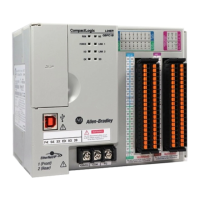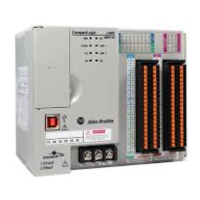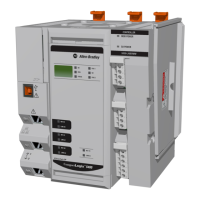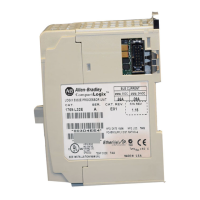Rockwell Automation Publication 1769-UM022C-EN-P - June 2018 87
Add and Configure Standard I/O Modules Chapter 6
Estimate Requested Packet Interval
The requested packet interval (RPI) defines the frequency at which the
controller sends data to and receives data from I/O modules. You set an RPI
rate for each I/O module in your system.
The Compact GuardLogix 5370 controllers attempt to scan an I/O module at
the configured RPI rate. For individual I/O modules, a Module RPI Overlap
minor fault occurs if there is at least one I/O module which cannot be serviced
within its RPI time.
The configuration parameters for a system determine the impact on actual RPI
rates. These configuration factors can affect the effective scan frequency for
any individual module:
• Rates at which RPI rates are set for other Compact I/O modules
• Number of other Compact I/O modules in the system
• Types of other Compact I/O modules in the system
• Application user task priorities
Table 9 - Requested Packet Interval Guidelines
You can set the RPI rates of individual Compact I/O modules higher than the
rates listed in Tabl e 9
. The RPI shows how quickly modules can be scanned,
not how quickly an application can use the data. The RPI is asynchronous to
the program scan. Other factors, such as program execution duration, affect
I/O throughput.
Type of Module Guidelines
(1)
(1) The guidelines in this table do not factor in the following items, which affect Compact GuardLogix 5370 controller CPU loading:
• I/O RPI timing does not affect the task priority. Event and periodic tasks have higher priority than I/O and user tasks.
• IOT (Immediate Output Instruction)
•Messaging
• CompactBus browsing such as DeviceNet network access through 1769-SDN with Compact GuardLogix 5370 Ethernet or
USB connection
Module RPI guidelines can require adjustment (increase of 1 ms or more) if Compact GuardLogix 5370 controller application
includes one or more of the listings in this table. Monitor controller minor faults to determine if Module RPI overlaps have
occurred.
All digital The following guidelines apply:
• 1…2 modules can be scanned in 0.5 ms.
• 3…4 modules can be scanned in 1 ms.
• 5…30 modules can be scanned in 2 ms.
Mix of digital
and analog or all
analog
The following guidelines apply:
• 1…2 modules can be scanned in 0.5 ms.
• 3…4 modules can be scanned in 1 ms.
• 5…13 modules can be scanned in 2 ms.
• 14…30 modules can be scanned in 3 ms.
Specialty The following conditions apply:
• For every 1769-SDN module in the system, increase the RPI of every other module by 2 ms.
• For every 1769-HSC module in the system, increase the RPI of every other module by 1 ms.
• For every 1769-ASCII module in the system, increase the RPI of every other module by 1 ms.
• For every 1769-SM2 module in the system, increase the RPI of every other module by 2 ms.

